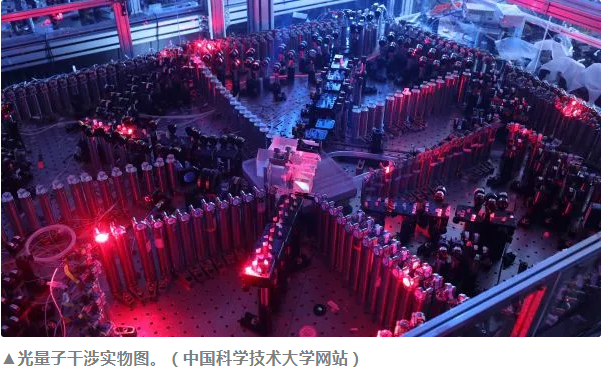US media: China's "nine chapters" demonstrate "quantum hegemony"
For the first time in history, a quantum computer built with photons has surpassed even the fastest classical supercomputer, according to US media.
A team of physicists led by Pan Jianwei and Lu Chaoyang from the University of science and technology of China (USTC), led by Pan Jianwei and Lu Chaoyang, realized the fast solution of the "Gaussian Bose sampling" task using the "nine chapters" prototype of quantum computing. According to a paper published online in the international academic journal Science, the result was 76 detected photons, far exceeding the previous record of five measured photons and the computing power of classic supercomputers.

The optical quantum interference physical figure. (website of University of science and technology of China)
Unlike traditional computers built with silicon processors, the "nine chapters" quantum computer is a sophisticated desktop device composed of lasers, mirrors, prisms and photon detectors, the report said. It's not a general-purpose computer that one day can send e-mail or store documents, but it can show the potential of quantum computing technology.
Computing power is far beyond the classical computer
Last year, Google made headlines, and its "sikomo" quantum processor took about three minutes to complete a task that took 10000 years for a supercomputer to complete. In its paper, the team of CUHK estimated that it would take an astonishing 2.5 billion years to perform the computing task of "nine chapters" by using the world's top supercomputer "Shenwei Taihu light".
The report pointed out that this is only the second time that scientists have demonstrated "quantum hegemony". The term describes a time when a quantum computer is exponentially faster than any classical computer to actually perform computing tasks that other devices cannot.
This time not only proves the principle, but there are some signs that "Gaussian boson sampling" may have practical uses, such as solving special problems in quantum chemistry and mathematics. More broadly, the ability to control photons as qubits is a prerequisite for building any large-scale quantum Internet. Quantum bits are similar to the bits used to represent information in the field of classical computing.
Scott Aronson is a theoretical computer scientist at the University of Texas at Austin. In 2011, he and his then student Alex alshibov pioneered the basic principles of Bose sampling. For many years, arenson said, boson sampling experiments have been limited to detecting only about three to five photons, which is "far from quantum hegemony". "It's hard to scale up, pay tribute to them," he said
In the past few years, quantum computing technology has leapt from obscurity to a multi billion dollar undertaking, and its potential impact on national security, the global economy and the foundations of physics and computer science has also been recognized, the report said. In 2019, the national quantum plan act of the United States was signed into law, and the United States intends to invest more than 1.2 billion US dollars (about 6.6 yuan per US dollar) in the field of quantum technology in the next 10 years. This field has also attracted a lot of hype, with some publishing unrealistic timetables and others boasting that quantum computers will completely obsolete classical computers.
According to the report, the latest action of CUHK team to demonstrate the potential of quantum computing is crucial, because the method it adopts is quite different from that of Google. "Xikemo" uses metal superconducting rings to form qubits, and in chapter nine, photons themselves are quantum bits. Lu Chaoyang said that this further independently confirmed that the principle of quantum computing can even realize "quantum hegemony" on completely different hardware. "Therefore, we are convinced that in the long run, it will be feasible to build useful quantum simulators and fault-tolerant quantum computers.".
Last year, the CUHK team demonstrated 14 photon Bose sampling, which is difficult for laptop computers, but easy for supercomputers. In order to expand the scale and ultimately achieve quantum hegemony, they adopted a slightly different protocol, namely "Gaussian boson sampling".
Christina Silberhorn, a quantum optics expert at the University of Paderborn in Germany and one of the developers of Gaussian boson sampling, said the technology was designed to avoid the unreliable single photon used by arenson and alcibov's vanilla boson sampling.
The report points out that Silberhorn admits that even so, the complexity of the CUHK installation is still daunting. The operation of "nine chapters" starts with a laser beam, which is divided into several beams to strike 25 crystals made of potassium Titanophosphate. When each crystal is hit, it reliably emits photons in two opposite directions. The photons are then fed into 100 inputs, where they quickly pass through a path of 300 prisms and 75 mirrors. Finally, these photons fall into 100 slits and are detected there. The average running time of the experiment was more than 200 seconds. The team of CUHK detected about 43 photons in each operation. But in one run, they observed 76 photons - enough to justify their claim to quantum hegemony.
 小任班长的博客
小任班长的博客 

